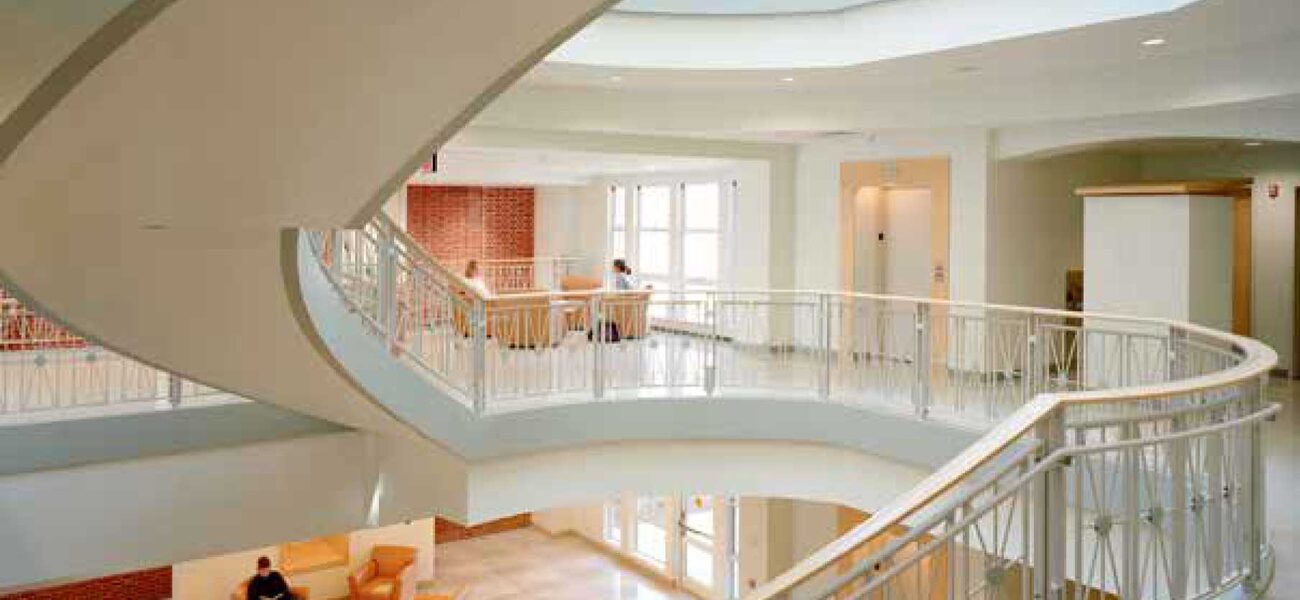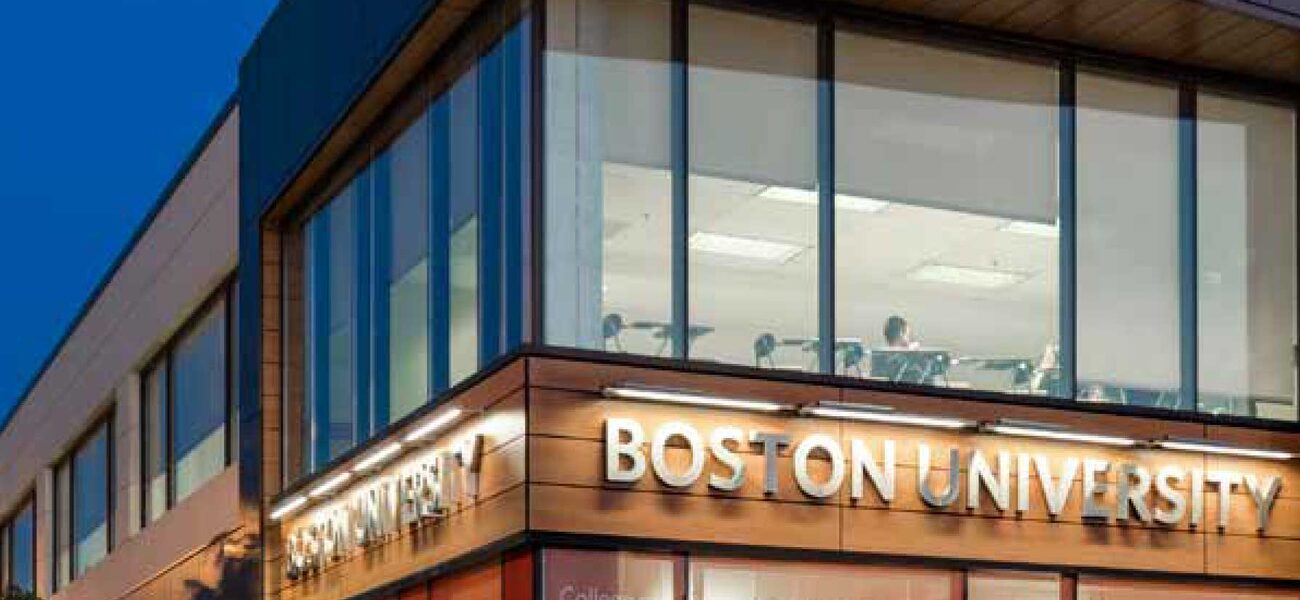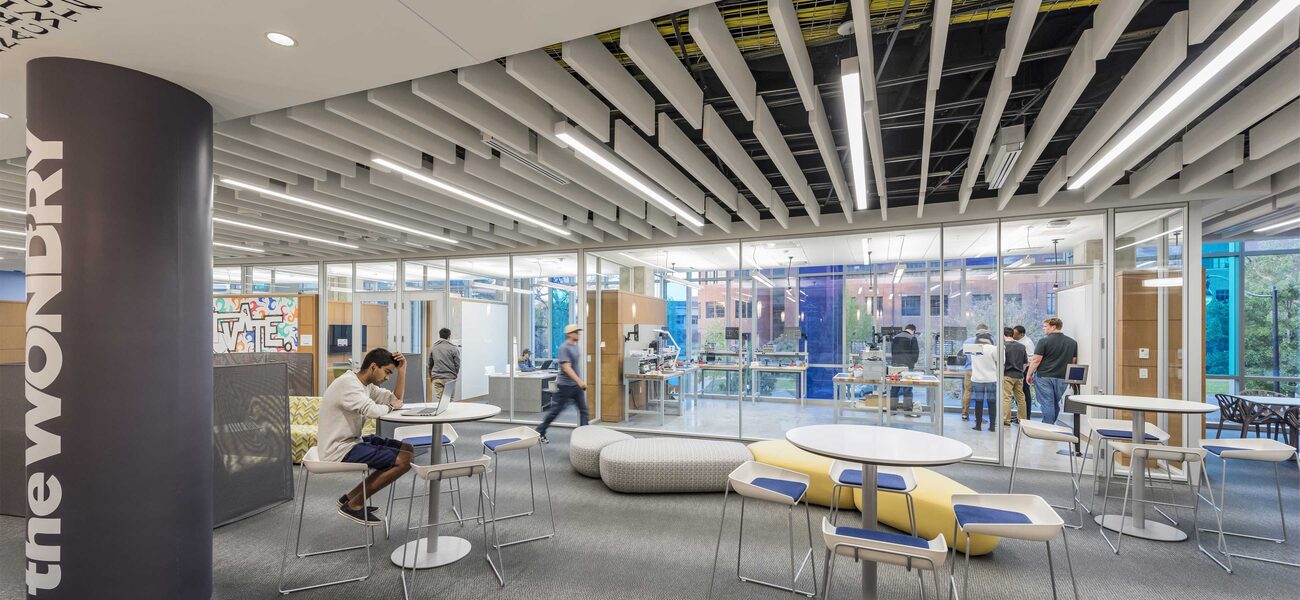“Convergence” is the term increasingly used to describe the intermingling of disciplines in next-gen academic research facilities. Embodied by today’s moonshot-type initiatives targeting big picture-level discovery, convergence has been dubbed “the next scientific revolution.” It is characterized by collaboration among experts in multiple fields of endeavor tackling the major scientific problems of our time. From a facility perspective, convergence goes beyond the organizational progression that has seen traditional departmental siloes challenged by the move to multidisciplinary, interdisciplinary, and transdisciplinary or clustered research. It brings together many diverse specialties, from biomedicine to engineering to business to law, in a single place.
“Convergence is more than borrowing things from different fields and putting them together to solve a problem. It creates a new field that is at the intersection of existing disciplines,” says Chris Martin, AIA, principal of Wilson Architects, citing an explanation offered by Mark Lundstrom, an engineering professor at Purdue University.
“The problems faced in the 21st century are broader, more complex issues that require multiple disciplines to come together in a strategic way to address,” says Martin.
“Convergence is about networks and pulling people from outside the sciences into the mix,” adds Cristianne Peschard, architect at Wilson Architects. “It requires people to think differently and work together. Their research is centered on a specific problem or issue rather than a discipline.”
Public Health on the Cutting Edge
As revolutionary as it is to the academic mainstream, today’s focus on convergent research is not without precedent. It has been a guiding principle at the nation’s schools of public health for decades. These institutions stand as an example because of the wide scope of the public health mission itself.
“All U.S. schools of public health have five core departments: biostatistics, epidemiology, environmental health, health education and behavioral sciences, and health policy and management,” explains Stephen Wisniewski, vice provost for data and information at the University of Pittsburgh. “The overall goal of these departments is to try to promote healthy lifestyles—with a large focus on the prevention of illness.”
At Pitt, this convergence promotes extensive collaborations, not only within the school but university-wide, with medicine, engineering, the law school, and social work, for example.
“To get this idea of public health out to the community, we need to work with a lot of different people,” says Wisniewski. Now that public health schools have laid the groundwork, the model can scale up to the next level of convergence required by other problem-solving initiatives with a similarly broad reach, he suggests.
Five Keys to Foster Convergence Science
Martin lays out the five interconnected ingredients that promote convergent research: people, culture, governance, workspaces, and partnerships.
People encompasses both the institutional leadership that drives the vision to search for solutions to complex problems, as well as the educators and researchers committed to engaging in the mission. “The leadership level at the academy needs to support the vision,” says Martin. “They have the requisite experience in marshaling resources and providing guidance.”
Educators and researchers must possess both a breadth and depth of experience. “Convergent researchers need a T-shaped skill set: a broad understanding of the sciences so they can speak the language of all the people they are working with, and a real depth in a specific field,” says Peschard. “Diverse perspectives support innovation.”
Martin points out that many of the scientists involved in these initiatives are younger faculty already accustomed to working in environments with disparate groups of expertise. “They have been trained in this manner and expect to operate in this manner. They actively seek this kind of knowledge base and environment.”
Culture fosters convergence by recognizing that “there are a lot of people in a lot of different settings within the school, from the wet bench area to dry research to actual teaching environments,” says Wisniewski.
To bring these people together he advocates including as much interactive space as possible in the building, from a first-floor common room for coffee to workspaces created by whiteboard-equipped hallways. “You can have a hallway conversation and start working out a problem right there,” he says.
Peschard echoes this recommendation, adding that newsletters and conferences, both internal and external, let occupants know who is doing what where. They are also effective reminders of the purpose of the organization and cultivate a sense of belonging.
At Pitt’s graduate School of Public Health, culture “is woven through the entire strategic plan—in how we teach, do our research, and count our service, the big three for faculty,” relates Wisniewski.
Governance—how spaces, especially labs, are organized and managed—is another critical ingredient, raising issues related to space assignments, tenure, salary, and funding.
“The convergent ecosystem is at cross-purposes with the typical academic structure,” explains Martin. “You may actually have a building that is organized around an initiative or a series of initiatives, and schools or departments are all recruited into that environment.”
Institutions might need to revisit standard tenure parameters and “expand the rules of what it means to participate,” he says. Researchers have to relinquish their proprietary sense of lab ownership, understanding that sharing space is essential “to play in this state-of-the-art sandbox with their peers. Younger scientists are ready to dive into that kind of environment.”
While an individual’s assigned space may be smaller, the opportunity to participate in a broader research group is highly valuable, and the university benefits in the form of high quality research, Peschard adds.
Workspaces have many dimensions. At the macro scale, says Peschard, selecting the right building location, in close proximity to related campus facilities, strengthens existing connections and enhances collaboration, thus cementing the network.
Flexibility is the watchword for the interior layout, with an emphasis on modular design that allows for outfitting the same space to do different things. Comparative models present useful guidelines for space allocation, especially when it comes to determining the ratios of wet, damp, and dry labs to be included, depending on whether the building is oriented more toward physical or life sciences.
One flexible configuration organizes spaces like cleanrooms or imaging cores around a common space, or ballroom. “They are thought of as functionality areas, for example, a spot where chemistry can be done. Instead of an individual lab, the faculty may have multiple locations within the building, with bench space in areas that support their activities.”
Incorporating a lot of transparent elements, like glass walls on cleanrooms that put the work on display, “provides the requisite clear understanding of how peers are operating within the space,” he says.
Partnerships are well represented at Pitt’s School of Public Health, both within and outside the university, from community medical centers, businesses, and foundations to the county and state departments of health and federal government agencies. For example, a study by a faculty member in the school has partnerships with 50 institutions across eight countries, working on initiatives around the evaluation of treatments for traumatic brain injury.
“Within those institutions, there are partnerships between radiologists, statisticians, bioinformaticians, critical care physicians, and neurosurgeons,” says Wisniewski. Resources for the global collaborations come from a number of different sources, including federal governments in Europe, Australia, and New Zealand.
Student Training
Convergent environments in academia entail a realignment of student training to prepare future graduates for the new workplace.
“Employers are actually looking for convergent people that can work on teams in a collaborative manner,” says Martin. “The generation of people coming into college and looking for jobs expects that kind of environment.”
He and Peschard mention five important considerations from the student perspective: access to technology, abundant collaborative space, empowerment, systems thinking, and buy-in.
While the students’ clamor for technology access and makerspace for hands-on work needs to be satisfied, it should not come at the expense of the in-person experience, advises Wisniewski. “Students still need one-on-one time with their instructors,” he says.
Collaboration space is in high demand. “Plan for those little spaces everywhere you can think of,” notes Peschard. “They will be used.”
Providing spaces where students can work together in groups empowers them, giving them a chance to have their own projects and to be self-directed, she adds.
Introducing the concept of systems thinking promotes a holistic approach to problem-solving, prompting students to envision the entire process, not just their own small piece of the whole.
Last, there is the issue of graduation path. “If working on projects and teams will delay graduation, you won’t have students wanting to do that,” cautions Peschard. “Make sure they can still fulfill core curriculum requirements.” If not resolved, this can be a major barrier to change.
Three Facility Models
What will the physical structure look like?
Peschard and Martin identify a three-point spectrum of facility models that represents the progression from what they call the “Mixer” to “P3: Public-Private Partnerships” to “STEM-plus” configurations.
The spectrum starts with the mixer, which might co-locate several departments in the same building with a central gathering feature like an atrium or a core facility. An example is Hood College’s Hodson Science & Technology Center, which combines chemistry, computer science, math, and biology departments in an 80,000-gsf facility that will allow collaborations to develop organically.
The introduction of industry partnerships has generated the theme- or problem-based facility model. Boston University’s 21,000-sf Engineering Product Innovation Center was created to bring product to market through partnerships with local industry. A fresh curriculum and industrial toolsets, like an updated assembly line and robotics research lab, give students hands-on experience throughout the design and fabrication processes.
The STEM-plus model “brings it all together,” embedding fabrication modeling and assembly under the same roof with STEM and other disciplines, like business. Vanderbilt University’s just-finished 235,000-gsf Engineering & Science Building is a transinstitutional collaboration that exposes undergraduates to research and forges a strong maker culture. An innovation center, The Wond’ry, acts as a catalyst for innovation and entrepreneurial projects.
“It is very transparent, and located inside the engineering building, making cleanroom and engineering labs highly visible to students outside the STEM disciplines, pulling them to participate in this convergent environment,” says Peschard.
By Nicole Zaro Stahl



